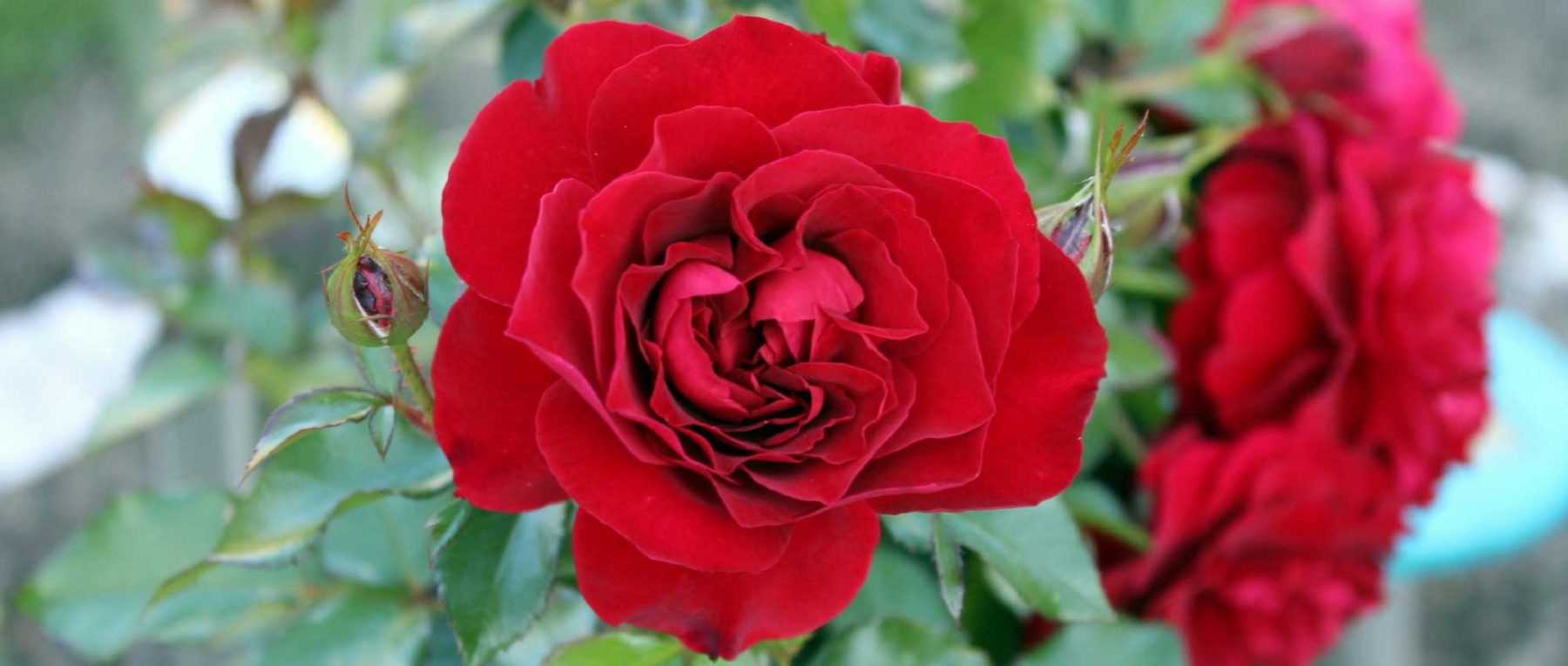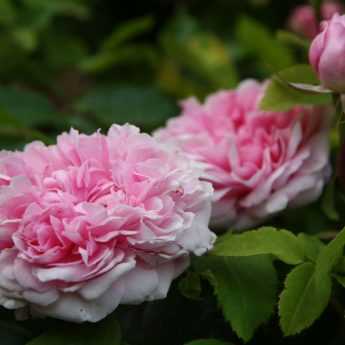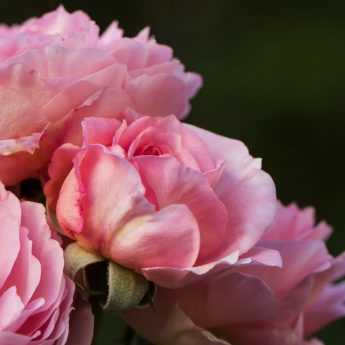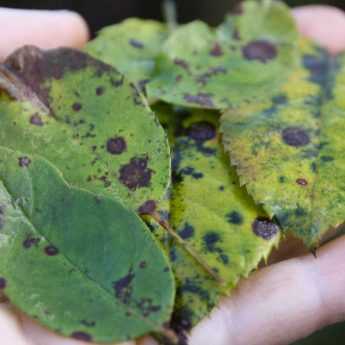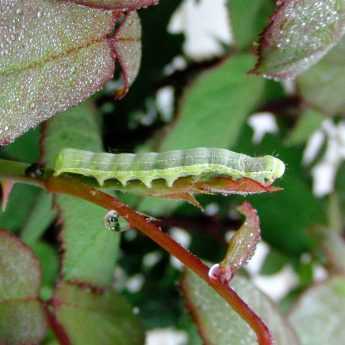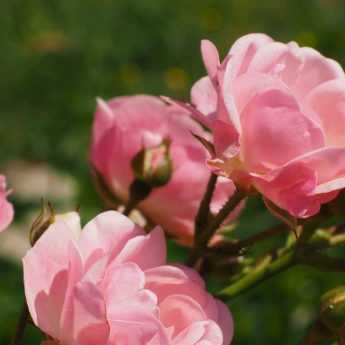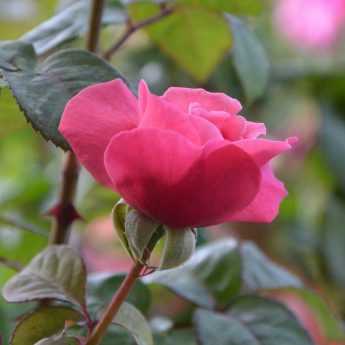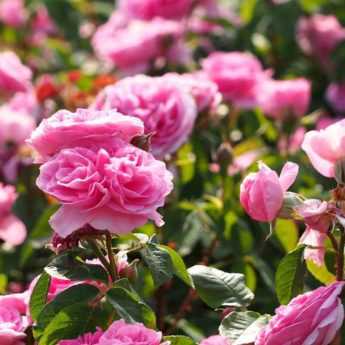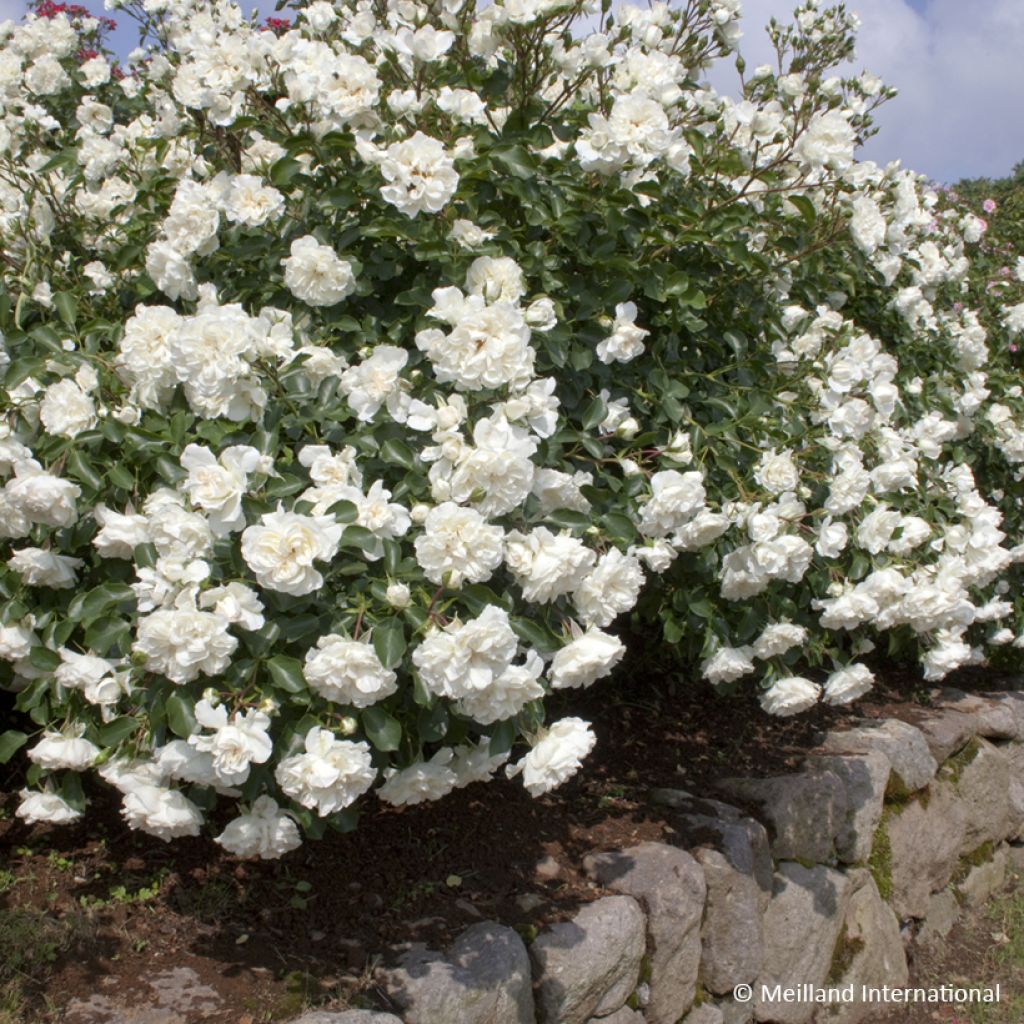

Rosa White Meillandecor - Groundcover Rose
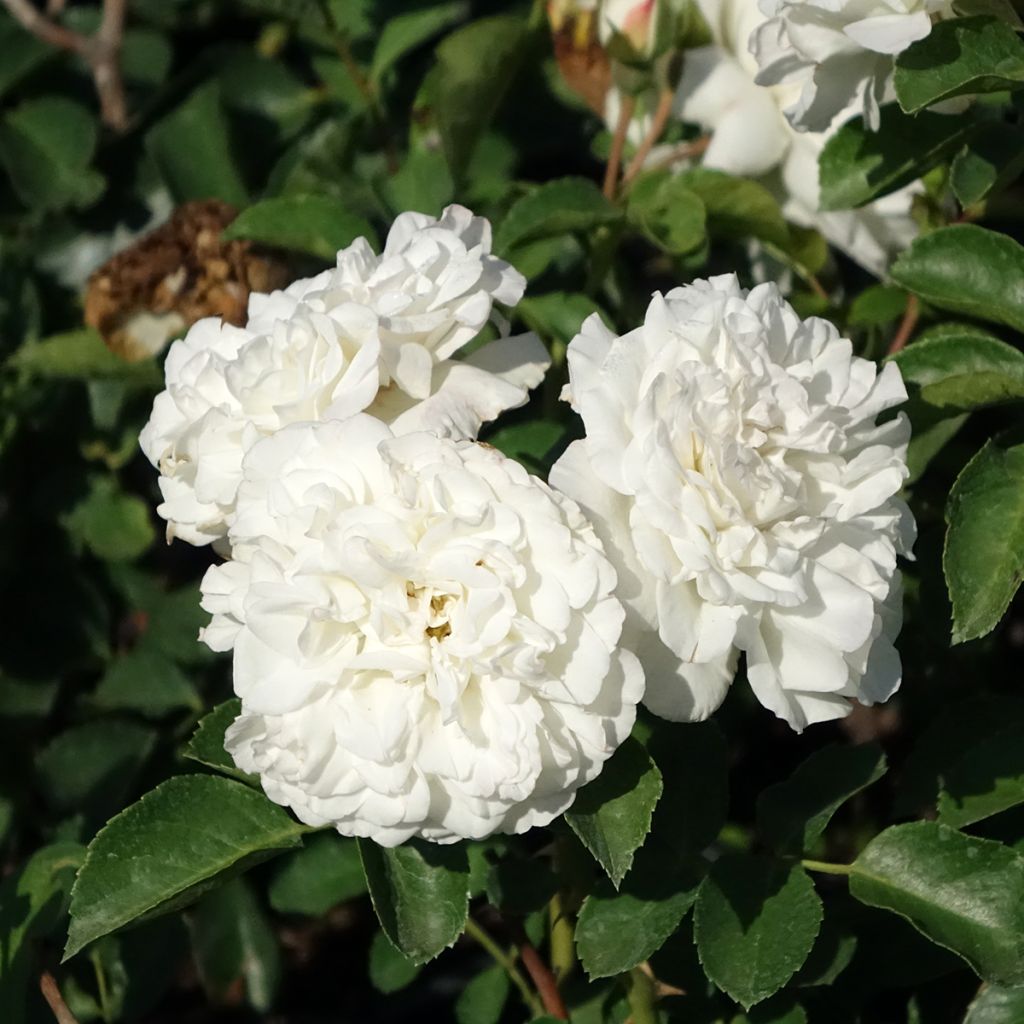

Rosa White Meillandecor - Groundcover Rose
Rosa White Meillandecor - Groundcover Rose
Rosa 'Meicoublan' WHITE MEILLANDECOR®
Home or relay delivery (depending on size and destination)
Schedule delivery date,
and select date in basket
This plant carries a 24 months recovery warranty
More information
We guarantee the quality of our plants for a full growing cycle, and will replace at our expense any plant that fails to recover under normal climatic and planting conditions.

Would this plant suit my garden?
Set up your Plantfit profile →
Description
The Blanc Meillandecor® Shrub Rose is a ground cover rose variety selected for its generous flowering and robustness. It stands out with its snow-white flowers subtly tinged with a creamy centre, which bloom in successive waves from May-June until the first frosts. Its compact and balanced habit makes it an excellent choice for structuring flower beds, dressing a slope, or enhancing a border. Its glossy dark green foliage provides an elegant contrast to the whiteness of the flowers whilst being highly disease-resistant. With its rapid growth and low maintenance, the Blanc Meillandecor vqriety is an ideal option for those seeking an easy-to-grow rose that is both decorative and bright.
The Blanc Meillandecor Rose 'Meicoublan' belongs to the Rosaceae family. It is also known as the White Meillandecor Rose or White Meidiland. It is characterised by its low, spreading habit forming a dense and harmonious bush. At maturity, it reaches approximately 50 to 80 cm in height with a similar spread, ensuring good ground cover and a balanced plant presence. Its flexible stems bear deciduous, dark green —dense and glossy— foliage which remains healthy throughout the season thanks to excellent disease resistance, particularly against powdery mildew and black spot. Its blooms of around 7 to 8 cm in diameter consist of 25 to 30 petals delicately arranged in an open cup shape. They display a snow-white hue warmed by a creamy centre, lending them natural elegance. Though unscented, they stand out for their abundant flowering which extends from late spring until the first frosts, ensuring an almost uninterrupted floral display. The bush produces dense clusters of hundreds of flowers renewed in successive cycles throughout the season. Unlike some more rigid varieties, the Blanc Meillandecor retains flexibility during growth, allowing it to integrate naturally into both classic and contemporary garden designs. Its well-developed root system ensures a good adaptability to challenging soil, including poor or slightly chalky ones.
The Blanc Meillandecor Rose adapts to many soil types as long as they are well-drained. It thrives in sunny exposures that are necessary to stimulate abundant flowering, but can also tolerate partial shade, particularly in regions with very hot summers. Its uniform habit makes it an excellent choice for group planting, where it creates a beautiful floral blanket that enhances garden contours. Thanks to its pure white colour, it pairs well with a wide range of perennials and shrubs. It adds a luminous touch to colourful flower beds when combined with plants featuring pastel blooms such as blue perennial geraniums, bellflowers, or catmint. In a structured border, it perfectly complements lavenders, artemisias, or perovskias, whose silver foliage highlights its immaculate glow. In a cottage garden, it pairs well with light grasses such as a Stipa tenuifolia or a Pennisetum alopecuroides 'Piglet', which add a touch of movement to the arrangement. Grown in a container on a patio, it forms a compact, floriferous bush, bringing a refined elegance to small spaces. Easy to grow and highly resilient, the Blanc Meillandecor rose will fit perfectly into any low-maintenance gardens where it offers long-lasting flowering and healthy foliage without requiring intervention.
Rosa White Meillandecor - Groundcover Rose in pictures
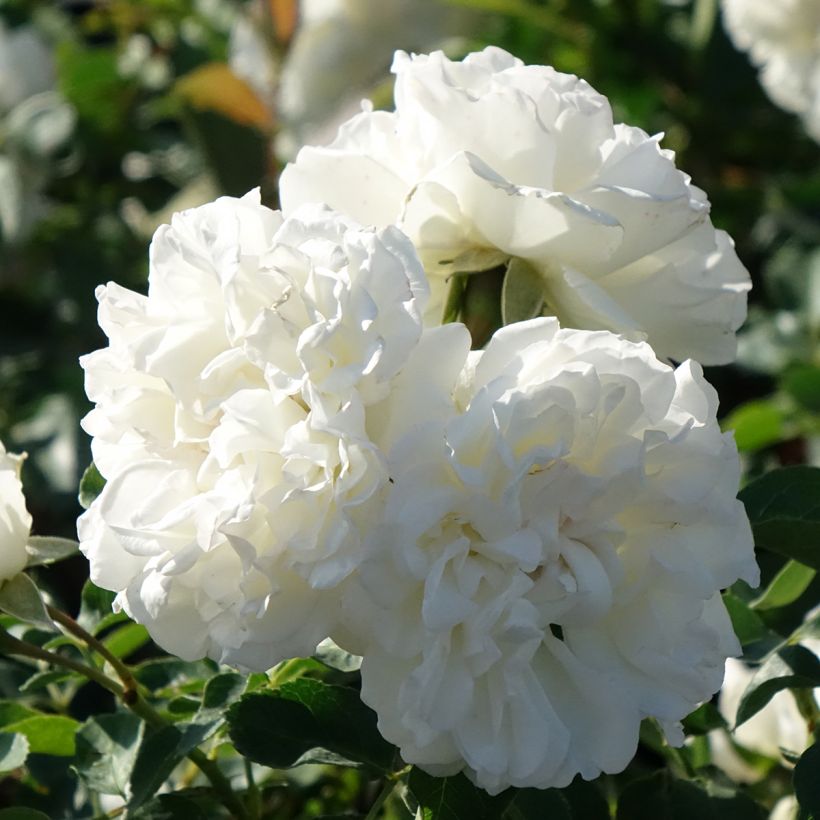

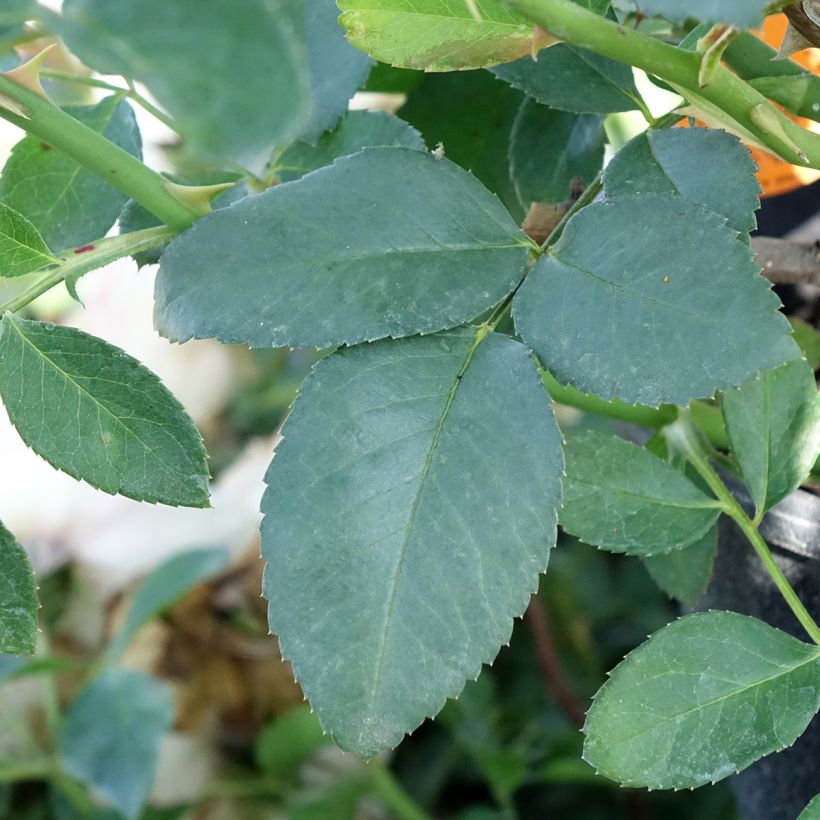

Plant habit
Flowering
Foliage
Botanical data
Rosa
'Meicoublan' WHITE MEILLANDECOR®
Rosaceae
Rosa 'Meicoublan' WHITE MEIDILAND, Rosa WHITE MEIDILAND
Cultivar or hybrid
Planting and care
The Blanc Meillandecor groundcover roses prefer a sunny position (at least 4 hours of sunlight per day) but sheltered from the scorching midday rays and strong winds. They thrive in loose, well-drained, humus-rich soil. They favour slightly acidic soil but will adapt to any garden as long as the ground is well-prepared and sufficiently fertile. Work the soil to a depth of 25 cm, breaking it up finely, and place a base fertiliser such as dried blood or dehydrated horn at the bottom of the planting hole. Position your plant after removing it from its pot, covering the top of the root ball with 3 cm of soil, backfill, and water thoroughly to eliminate any air pockets. During dry weather, water regularly for a few weeks to encourage root establishment. Also, remember to feed your rose with a special rose fertiliser to promote flowering.
Roses often develop spots or look unsightly by late summer, but this does not affect their growth. These spots are not harmful to the plant—it's a natural occurrence. Follow all our advice to address this issue and read our article: Help! My Roses Have Spots
Planting period
Intended location
Care
Planting & care advice
This item has not been reviewed yet - be the first to leave a review about it.
Haven't found what you were looking for?
Hardiness is the lowest winter temperature a plant can endure without suffering serious damage or even dying. However, hardiness is affected by location (a sheltered area, such as a patio), protection (winter cover) and soil type (hardiness is improved by well-drained soil).

Photo Sharing Terms & Conditions
In order to encourage gardeners to interact and share their experiences, Promesse de fleurs offers various media enabling content to be uploaded onto its Site - in particular via the ‘Photo sharing’ module.
The User agrees to refrain from:
- Posting any content that is illegal, prejudicial, insulting, racist, inciteful to hatred, revisionist, contrary to public decency, that infringes on privacy or on the privacy rights of third parties, in particular the publicity rights of persons and goods, intellectual property rights, or the right to privacy.
- Submitting content on behalf of a third party;
- Impersonate the identity of a third party and/or publish any personal information about a third party;
In general, the User undertakes to refrain from any unethical behaviour.
All Content (in particular text, comments, files, images, photos, videos, creative works, etc.), which may be subject to property or intellectual property rights, image or other private rights, shall remain the property of the User, subject to the limited rights granted by the terms of the licence granted by Promesse de fleurs as stated below. Users are at liberty to publish or not to publish such Content on the Site, notably via the ‘Photo Sharing’ facility, and accept that this Content shall be made public and freely accessible, notably on the Internet.
Users further acknowledge, undertake to have ,and guarantee that they hold all necessary rights and permissions to publish such material on the Site, in particular with regard to the legislation in force pertaining to any privacy, property, intellectual property, image, or contractual rights, or rights of any other nature. By publishing such Content on the Site, Users acknowledge accepting full liability as publishers of the Content within the meaning of the law, and grant Promesse de fleurs, free of charge, an inclusive, worldwide licence for the said Content for the entire duration of its publication, including all reproduction, representation, up/downloading, displaying, performing, transmission, and storage rights.
Users also grant permission for their name to be linked to the Content and accept that this link may not always be made available.
By engaging in posting material, Users consent to their Content becoming automatically accessible on the Internet, in particular on other sites and/or blogs and/or web pages of the Promesse de fleurs site, including in particular social pages and the Promesse de fleurs catalogue.
Users may secure the removal of entrusted content free of charge by issuing a simple request via our contact form.
The flowering period indicated on our website applies to countries and regions located in USDA zone 8 (France, the United Kingdom, Ireland, the Netherlands, etc.)
It will vary according to where you live:
- In zones 9 to 10 (Italy, Spain, Greece, etc.), flowering will occur about 2 to 4 weeks earlier.
- In zones 6 to 7 (Germany, Poland, Slovenia, and lower mountainous regions), flowering will be delayed by 2 to 3 weeks.
- In zone 5 (Central Europe, Scandinavia), blooming will be delayed by 3 to 5 weeks.
In temperate climates, pruning of spring-flowering shrubs (forsythia, spireas, etc.) should be done just after flowering.
Pruning of summer-flowering shrubs (Indian Lilac, Perovskia, etc.) can be done in winter or spring.
In cold regions as well as with frost-sensitive plants, avoid pruning too early when severe frosts may still occur.
The planting period indicated on our website applies to countries and regions located in USDA zone 8 (France, United Kingdom, Ireland, Netherlands).
It will vary according to where you live:
- In Mediterranean zones (Marseille, Madrid, Milan, etc.), autumn and winter are the best planting periods.
- In continental zones (Strasbourg, Munich, Vienna, etc.), delay planting by 2 to 3 weeks in spring and bring it forward by 2 to 4 weeks in autumn.
- In mountainous regions (the Alps, Pyrenees, Carpathians, etc.), it is best to plant in late spring (May-June) or late summer (August-September).
The harvesting period indicated on our website applies to countries and regions in USDA zone 8 (France, England, Ireland, the Netherlands).
In colder areas (Scandinavia, Poland, Austria...) fruit and vegetable harvests are likely to be delayed by 3-4 weeks.
In warmer areas (Italy, Spain, Greece, etc.), harvesting will probably take place earlier, depending on weather conditions.
The sowing periods indicated on our website apply to countries and regions within USDA Zone 8 (France, UK, Ireland, Netherlands).
In colder areas (Scandinavia, Poland, Austria...), delay any outdoor sowing by 3-4 weeks, or sow under glass.
In warmer climes (Italy, Spain, Greece, etc.), bring outdoor sowing forward by a few weeks.


































